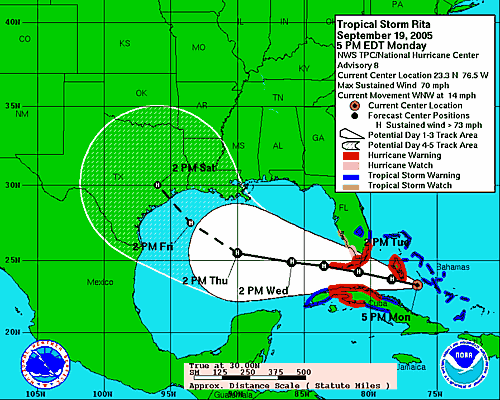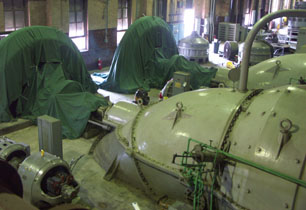A tropical depression heading toward the Florida Straits and the Gulf of Mexico is driving the U.S. Army Corps of Engineers to redouble its efforts to shore up battered storm protections in New Orleans and surrounding parishes, just as the mission to drain the flood from Hurricane Katrina nears its end.

|
| Tropical Storm Rita five-day coastal watches and warnings.(Illustration: NOAA) |
A forecast Sunday morning, Sept. 18, predicted the weather system will strengthen to tropical storm status, be named "Rita," and then move through the Florida Keys into the Gulf of Mexico. Its effects may threaten New Orleans' crippled defenses by Thursday, even if the storm makes landfall far away.
Some early models predict a landfall in Texas, in which case the storm could send 15- to 20-knot winds and 4-ft to 6-ft seas toward the battered Mississippi and Louisiana coasts. Other models say the storm could take aim on the wounded northern Gulf Coast instead. Either possibility was enough to send the engineers scrambling to shift the focus from getting the last of Katrina's water out of the city, to making a detailed evaluation of the drainage system's current capacity and devise a strategy to manage a heavy rain event, or even a new inundation. Task Force Unwatering is segueing into Task Force Guardian, a levee repair command being organized by the Corps' District office in St. Louis.
"It doesn't take a major storm. It doesn't even take a tropical storm. That's the kicker," says Col. James Rowen, commander of the Corps engineering research and development center at Vicksburg, Miss. Rowen showed maps of computer modeling of the extent of flooding the city could experience from rain alone at current drainage capacities from 3-in.., 6-in. and 9-in. rainfalls in a six-hour period. He presented them to a briefing at the Emergency Operations Center at the Corps' New Orleans District office on Sunday morning. In the larger rain event scenario, the water depths and extent of flooding would un-do much of the pumping of the past two weeks.
Joseph Sullivan, the general superintendent of the New Orleans Water and Sewage Board, reports the city's damaged storm-water removal system currently has about 20% of its of its pre-Katrina capacity. Before the hurricane it could be counted on to handle an inch of water in the first hour of a storm, then � inch an hour for succeeding hours without flooding. The Corps reports about half of the city's installed pumps, with a total 61,000 cfs capacity are mechanically operational, but there are many constraints, including limitations on power supply, that keep them all from running flat-out. There is another 1,470 cfs capacity in the larger 24-, 30- and 42-inch portable pumps available. These pumps have been placed across the four major drainage basins.
 |
| It will take two weeks to dry the windings for the high-capacity pump station, the Corps says.(Photo: Tom Sawyer) |
Work to restore the city's pumps to full capacity has been progressing steadily, but the job requires more time, Corps officials say. The city has 21 pump stations. Most have multiple pumps, and the electric motors that drive them were at least partially submerged in the flood. The windings on each motor must be thoroughly dried before re-energizing, a process which will take about two weeks once floodwaters are withdrawn. General Electric Co. has a contract with the New Orleans Sewerage & Water Board to put a drying team on every pump, although the technique was changed Saturday after a heating tarp on a pump at Station No. 6 caught fire. Now the crews are charging the windings with power from generators to heat them up and drive out the moisture without blanketing the motors.
The Corps has asked FEMA for another $117 million on top of the original $50 million allocated for unwatering, as the necessity for continued levee and pump repairs grows.
The condition of the damaged levee system is most worrisome. Even a modest storm surge could overtop or breach the scoured or weakened areas and re-flood the city. Of particular concern are the breaches of the 17th St. and London Ave. canals. Corps officers say they have been plugged sufficiently to allow the draining of surrounding neighborhoods, but without significant further strengthening they would be no match for another major storm. Temporary floodgates now installed across the mouths of those two canals could block a surge from backing up into the canals, bursting the walls and re-flooding the residential areas, but closing the gates would also mean the big municipal drainage pumps that use the canals as outfalls would have to be shut down, most likely leading to another flood anyway. The city's biggest pump station, No. 6, with a capacity of almost 10,000 cfs, and the vital station No. 1, which keeps a vital interstate highway interchange clear, would both have to be shut down if the 17th St. Canal were closed.
The outer storm defenses along St. Bernard and Plaquemines Parishes to the south and east are largely gone. The Corps has conducted Light Detection and Ranging (LIDAR) surveys by helicopter of all the levee systems. The remote-sensing data is being processed to produce a detailed survey of the extent of loss so engineers can plan for reconstruction, although the results will not be available until Sept. 21.
|
The outer storm defenses along St. Bernard and Plaquemines Parishes to the south and east are largely gone. The Corps has conducted Light Detection and Ranging (LIDAR) surveys by helicopter of all the levee systems. The remote-sensing data is being processed to produce a detailed survey of the extent of loss so engineers can plan for reconstruction, although the results will not be available until Sept. 21.
The effect of the new storm threat on plans to allow some city residents to return to drier neighborhoods was unclear, but water, sewer and power issues remain whether the storm attacks the city or not. Sullivan says sewer system repairs are being handled by the system's contract operator, but arrangements for the water system repairs are still being settled. The main issue there, he says, is an untold number of pipe breaks, many of which were caused by falling debris or trees toppling over and damaging underground lines pulled out with their roots.

Post a comment to this article
Report Abusive Comment